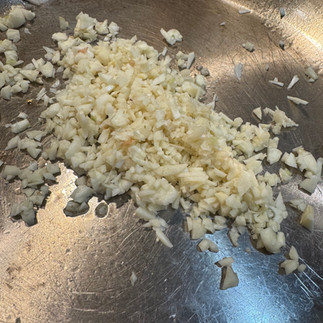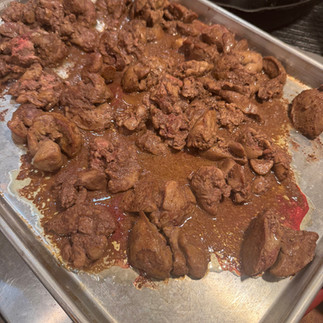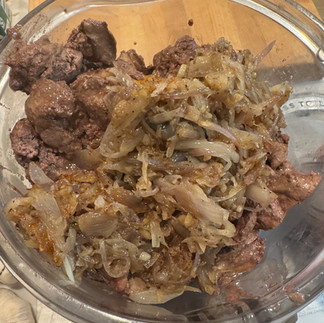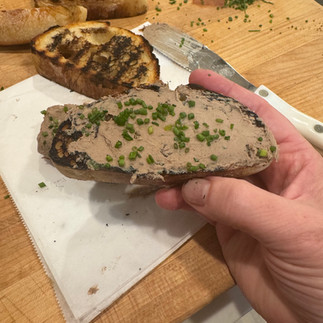
You best believe I turned my nose at chicken liver mousse the first time my cousin Cindy made it for me.
Ewww, chicken livers? Yuck!
But she made it really simple to comprehend, “how could all of France be wrong. Just try it, god damn it!”
She had a strong personality. It was hard to say no to Cindy.
Crusty grilled bread.
A schemer of “pâté”
(Close your eyes and just take a bite, Carol… don’t be a wimp)
Bite.
Crunch.
(Breathe to release the aroma)
Chew.
Swallow.
I didn’t die.
Hey… that actually was delicious.
Silky smooth and pleasantly palatable.
I think I’ll have another.
Fast forward, say 5 or so years. I’m pregnant with my third child. A boy. (Only kid i found out the sex of before giving birth).
“They” say you carry boys and girls differently. And you crave different foods.
“They” were right.
With my girls, by the end of the pregnancy I was craving sweets. Ice cream and orange juice. Not together- But well that actually isn’t a bad combo (think DQ Orange Julius 🍊)
With my son, I wanted meat! IRON!! And milk. Not your wimpy skim milk—- I wanted whole fat thick milk. Must’ve been the testosterone in my body. And I wanted to eat them together.
Cindy pulled through again- making me chicken livers mousse (pâté). And I ate it all!! Except this time she taught me how to make it.
Teach a (wo)man to fish, you know?
As you’ll learn below, it’s a time consuming process. Several steps to use what was once a prize possession of nose to tail ancient consumers - now possibly the least expensive product of the chicken- to make this delicable dish. Renowned high end restaurants hold this modest dish with the utmost regard.
Humble Beginnings
Chicken liver mousse has risen to prominence as a luxurious delicacy on modern menus, celebrated for its smooth texture, rich flavor, and decadent creaminess. But this dish’s origins are far humbler, rooted in the resourceful, nose-to-tail cooking practices of early cultures.
Ancient cultures revered the liver as a symbol of life and sustenance, and it was often considered a prized part of the animal. Greeks and Romans are thought to be some of the earliest civilizations to prepare liver-based dishes, blending it with herbs and spices to offset its naturally strong flavor. The Romans, in particular, created an early version of liver pâté by mixing animal livers with figs and honey, experimenting with ingredients to develop new flavors and textures.
As centuries passed, liver pâtés became more refined and widespread across Europe, embraced by nobles and peasants alike. The dish continued to evolve, especially in France, where various pâtés were developed, including those made from duck, goose, and chicken livers.
French Influence: Chicken Liver Mousse Finds its Form
While goose and duck liver pâtés, such as foie gras, are often celebrated, chicken liver mousse took a different path. By the 17th and 18th centuries, resourceful French cooks began using chicken liver as a more accessible and affordable alternative. Cooks found that blending chicken liver with butter, cream, or wine could create a smooth, spreadable mousse, ideal for pâtés and terrines.
Chicken liver mousse became a staple in French farmhouse kitchens, especially in rural areas where families used every part of the bird. The addition of local herbs, onions, and brandy brought out the rich, earthy flavors of the liver, creating a new, versatile spread that was delicious, practical, and affordable.
Rising Popularity: Chicken Liver Mousse in Fine Dining
In the 20th century, chicken liver mousse went through a transformation, evolving from a rustic farmhouse staple to a fine dining favorite. The classic French recipe, which calls for cooking the livers in butter with shallots, garlic, and sometimes cognac, gained international acclaim. Chefs began refining techniques to create the silkiest texture possible, often passing the liver mixture through fine sieves to achieve a delicate, velvety consistency.
Chicken liver mousse found a special place in upscale French restaurants, particularly in Paris, as chefs elevated the traditional dish with innovative ingredients and presentations. This delicacy made its way onto charcuterie boards and appetizers, alongside pickled vegetables, toasted baguettes, and sweet fruit jams for a contrast of flavors.
Modern Twist: Chicken Liver Mousse Around the World
Today, chicken liver mousse has achieved global appeal, and chefs worldwide are putting their own twists on this classic dish. From Italy to the United States, modern kitchens have embraced it, experimenting with new flavors like truffle, honey, or spices, and often infusing cultural ingredients to create unique fusions. For example, Japanese chefs may add miso or soy sauce, while American chefs use bourbon or other local spirits to enhance the flavor.
Making It at Home: A Nod to Tradition
Chicken liver mousse remains one of the most versatile, flavorful dishes that can be made at home with a few simple ingredients. Following in the footsteps of early cooks, home chefs can blend chicken livers with cream, butter, and spices to create a spread that’s both affordable and elegant.
From its ancient origins to its place in contemporary cuisine, chicken liver mousse tells the story of culinary evolution, resourcefulness, and indulgence. Whether spread on toast at a fine restaurant or enjoyed at home with family, chicken liver mousse is a testament to how humble ingredients can be transformed into something extraordinary. As chefs continue to experiment with this dish, it’s clear that chicken liver mousse will remain a timeless favorite, celebrating both tradition and creativity in every bite
Cooking Class with Carol
Things to Consider.
Chicken livers normally can be found in the freezer section of your local grocery store.
Allow to thaw in refrigerator as opposed to a quick thaw method. The integrity of the protein can be lost in the quick thaw process.
Clean and trim well, discarding any membranes or discolors parts.
Pat dry thoroughly to avoid splattering when you cook the livers.
Season with salt. Pepper at the end so it doesn’t burn in the pan.
Create your own flavor profiles.
OR.
Don’t reinvent the wheel.
Europe has done a bang up job of figuring out the exact best flavor profiles.
France perfected it.
Recipe

1/2 pound chicken livers, well-trimmed
1/2 small shallot, thinly sliced
1 small garlic clove, smashed and peeled
1 bay leaf
1/4 teaspoon thyme leaves
1/2 teaspoon kosher salt, plus more to season
1/2 cup 1/2 and 1/2 or heavy cream
1 1/2 sticks unsalted butter, at room temperature
2 teaspoons Cognac or Scotch whisky
Freshly ground black pepper
Toasted baguette slices, for serving
What To Do
In a medium saucepan, combine the shallots garlic, thyme, bay leaf. Sauté on medium for 5-7 minutes or until shallots are translucent. and 1/2 teaspoon of salt.
Add the livers and cook for 2-3 minutes each side.
Deglaze pan with cognac.
Cover, reduce the heat to low, and cook, stirring occasionally, until the livers are barely pink inside, about 3 minutes. Remove from the heat and let stand, covered, for 5 minutes.
Move mixture (discard bay leaf and stems of thyme) to food processor and pulse until smooth, slowly add cream. Salt and pepper to taste. Pass through a fine sieve to remove any lumps and yield a smooth textured pate.
Line a loaf pan with cling wrap. Scoop the mixture into the loaf pan, smoothly out top.
Cover and refrigerate for 2 hours or until set.
Grill your favorite crusty bread. When the bread is sufficiently grilled and slightly cooled, run a raw piece of garlic across the crusty bread for extra umami.
Schmear a copious amount of pate on grilled bread. Garnish with chives.
Slice pate as needed. Lasts 3-5 days covered in the refrigerator.
ENJOY!! 😊










































Comments